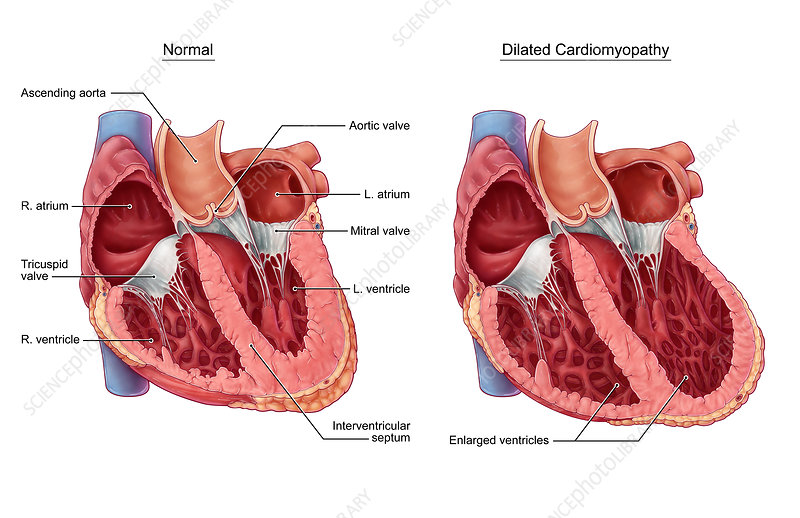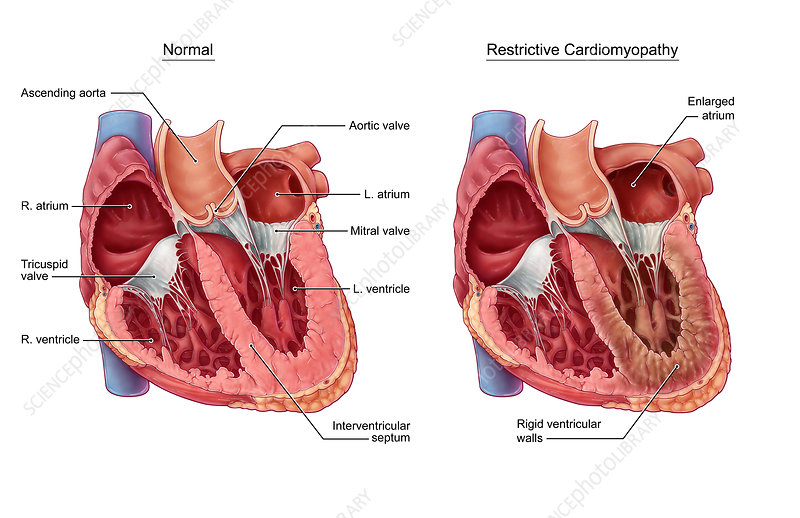Cardiomyopathy is disease to to the heart muscle. It literally translates straight across; “Cardio” meaning heart, “Myo” meaning muscle, and “Pathy” meaning disease. That being said this a real generalized broad term and can go into much more detail. There are two basic categories of cardiomyopathy. There is secondary cardiomyopathy and primary cardiomyopathy. Secondary cardiomyopathy develops when the heart muscle is trying to compensate for other underlying diseases like hypertension or valve diseases and primary cardiomyopathy is when the problems develop by the heart it’s self. There are five general types of cardiomyopathy that can develop from either primary or secondary cardiomyopathy and those can be dilated, hypertrophic, restrictive, left ventricular non-compaction, and arrhythmogenic right ventricular dysplasia. Today I am only going to comb over three as this topic can easily become compounded with it being so broad.
Dilated cardiomyopathy(DCM) usually will start in the heart’s main pumping chamber which is the left ventricle. The ventricle stretches and thins and can’t pump as well as a healthy heart can. This stretching and thinning is where the name “dilated” comes from and essentially this is from your heart stretching to hold more blood to pump through the body but this only works for a while before the heart muscle walls weaken and aren’t able to pump as strongly. Over time it is possible for both ventricles to become affected by this disease. DCM is also widely know as one of the most common types of cardiomyopathy and can often lead to heart failure, heart valve problems, arrhythmia, and blood clots in the heart. This type of cardiomyopathy is known to mostly occur in adults from around age 20 to age 60. Also, it is often unknown what caused the disease and about one-third of the time it can be traced back to inheritance from their parents. There are known disease and substances that can cause the disease and some of them are coronary heart disease, heart attack, high blood pressure, diabetes, Infections(especially ones that inflame the heart muscle), Alcohol, pregnancy complications, toxins such as cobalt, and some recreational drugs (mostly ones that are known to be stimulants). DCM is often diagnosed based on your medical history, a physical exam, or other specific tests such as electrocardiogram(ECG), chest X-ray, echocardiogram, CT scan, MRI scan, and others.
Hypertrophic cardiomyopathy(HCM) is a pretty common type of cardiomyopathy after DCM. This disease is where the heart muscle becomes abnormally thick and prevents the flow of blood to the heart and can make it harder for the heart to pump blood. One of leading causes for this disease is attributed to genetics but it can also be caused by diabetes, thyroid conditions and long term blood pressure conditions. Though this disease can often go diagnosed, as many people can have little to no symptoms, there is a small number of people that can experience shortness of breath, chest pains, problems with the hearts electrical system which then can result in life-threatening abnormal heart rhythms or sudden death. Some complications that HCM can lead to atrial fibrillation, blocked blood flow, mitral valve problems, DCM (like talked about before) and heart failure. If you have a parent that has HCM there is a 50% chance that may have inherited the gene and it is a good idea to get tested on a regular bases to try to identify the signs as early as possible and those athletically active should be at least tested once a year.
Restrictive cardiomyopathy(RCM) often develops as a way to try to compensate for some other underlying disease like hypertension or valve diseases and it is where the the muscle of the heart becomes stiffer and compliant to expansion and contraction. Unlike the other diseases we’ve talked about the muscles often mostly stay the same size or are maybe only slightly enlarged. Normally when blood fills the ventricles they are compliant so the stretch out and allow more blood to into the heart this leads to the heart having to work harder to compensate or just leads to the heart to start failing to pump enough blood to the rest of the body. This leads to heart failure and since filling happens during diastole, which is the phase of the heartbeat when the heart muscle relaxes, we say that this type of heart failure is diastolic heart failure. There are several things that can cause stiffer heart muscles. One of those is know as amyloidosis, which is when proteins called amyloids have been folded improperly which leads to them becoming insoluble and can deposit in various tissues and organs making them less compliant. Often this happen due to a genetic disorder passed on from past generations. This genetic disorder is where mutant transthyretin proteins(TTR) is misfolded and prone to depositing in the heart tissue. TTR is a protein that usually circulates in the blood and helps to transport thryoxine and retinol. These mutation are known to be more common in African Americans. Similarly, senile cardiac amyloidosis is where, over time, wild-type or normal TTR deposits in the heart and this is typically seen in the elderly. Sarcoidosis is something else that can cause RCM and this is when something known as granulomas, which are collections of immune cells, form in the heart tissue. Others are; endocardial fibroelastosis where fibrosis forms in the endocardium, which is the inner lining of the heart, as well as the subendocardium which resides right under that, endocardial fibroelastosis, that happens most often in children, and is thought to be caused by a variety of diseases and stresses like infections and even nutritional deficiencies, and finally the last one we’ll cover is hemochrom
We aren’t going to go into the other portions of this subject as this post is already starting to become really long and and I have already done my best to not fall down the many interesting rabbit holes this broad subject can have. Learning about the heart is always extremely interesting and I think we often find it appealing because it is truly an impressive organ and has such an immediately recognizably vital roll in the function of basically everything. I hope to dig into this again and cover these subject sub-categorizes in more depth as well as the ones I didn’t get a chance to cover. Here at CPR and More we are extremely focused on heart health and what to do in the case of heart complications or the things surrounding the subject. If you ever know someone or you yourself have heart complications we know how important it is for those around us to know CPR and AED techniques and that is why we are here to help!




